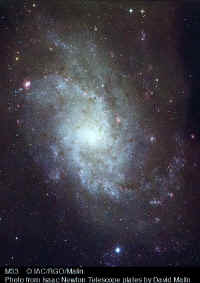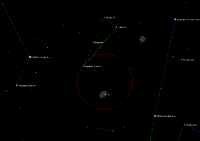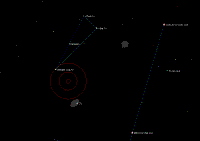M33 (galaxy in Triangulum)
090: M33 image
M33 is a very large, very dim spiral galaxy in Triangulum. M33, along with Andromeda and the Milky Way, is a member of the Local Group of galaxies. Current thinking is that M33 is in fact a gravitationally-bound satellite of M31, just as M31 is a satellite of the Milky Way. M33 was originally known as the Pinwheel Galaxy, but that is easily confused with M101, the Pinwheel Galaxy, or M83, the Southern Pinwheel Galaxy. For clarity, most astronomers call M33 the Triangulum Galaxy or the Triangulum Pinwheel Galaxy.
M33 may have been first observed by the Italian astronomer Giovanni Batista Hodierna prior to 1654. It’s hard to know for sure, because Hodierna wasn’t very good at noting the coordinates of objects he’d observed. Charles Messier independently discovered M33 on August 26, 1764, one of the many objects he first logged that year. In his log, Messier noted,
“Nebula discovered between the head of the Northern Fish & the great Triangle, a bit distant from a star of 6th magnitude: The nebula is of a whitish light of almost even density, however a little brighter along two-thirds of its diameter, & contains no star. One sees it with difficulty with an ordinary telescope of 1-foot.”
M33 is of the same general type as the Andromeda group of galaxies and our own Milky Way galaxy, but much smaller. With a longest dimension of 50,000 to 60,000 light years, M33 has about half the extent of the Milky Way, and at an estimated mass of 10 billion to 40 billion suns, less than 1/20th the mass. But Andromeda and the Milky Way are very large galaxies, so M33 is probably average in size and mass for a spiral galaxy.
Although I mentioned earlier that M31 is the most distant object readily visible to the naked eye, some people have reported being able to glimpse M33 using averted vision under very dark skies. At 3,000,000 light years, M33 is about 100,000 light years more distant than M31.
100: M33 with Binoculars
M33 is another Messier Object that you may find easier to observe with binoculars than with a telescope. The Astronomical League rates M33 as a “Tougher” object in 7X50 binoculars, although at Bullington I’d rate it a “Challenge”. It’s huge—about 73 by 45 arcminutes—and very dim. M33 is actually easy to find, but hard to see. It’s quite possible to have it centered in your eyepiece and not be able to see it. Sometimes tapping the scope gently causes it to give itself away. Although M33 is easy enough to find, it’s the hardest object to see of any we’re covering tonight, and on that basis it’s the only one I’ve assigned a “5”, my most difficult rating.
To get it in your binoculars, center the apex of Triangulum, Metallah or Caput Trianguli, in your field. Swing your binoculars toward Mirach in Andromeda until Metallah is at the edge of the field. M33 will be about halfway out from the center of the field, in the orientation shown. With binoculars, you’ll probably see at most a hazy gray smudge, and you may have to use averted vision to see that. M33 is extremely sensitive to light pollution, and I’ve been able to bag it at Bullington only a couple of times. If you want to log M33, try from the darkest skies you can get to.
110: M33 with Telrad
To get M33 in your telescope, use the lowest-power, widest-field eyepiece you have. Put your Telrad on Metallah and pivot the scope toward Mirach until Metallah is on the edge of the 4 degree circle. Continue in the same direction for half a Telrad field, and then move the Telrad about a quarter field at 90 degrees to the Metallah—Mirach line, as shown. At that point, M33 should be centered in your finder. If you have a 50mm finder, M33 may be just visible as a very faint gray smudge. In a 30mm finder, it won’t show at all.
Even once you have M33 centered in your main scope, don’t expect much at Bullington. I’ve had M33 in the main scope several times at Bullington and called others—including some fairly experienced observers—over to look. The most common comment is, “Where is it? I don’t see anything at all.” That’s M33 in a nutshell. It’s extremely sensitive to light pollution, so the best time to get it is on an extremely clear, extremely dark night when it’s near zenith. At Bullington, even a crescent moon makes M33 almost impossible to see.


